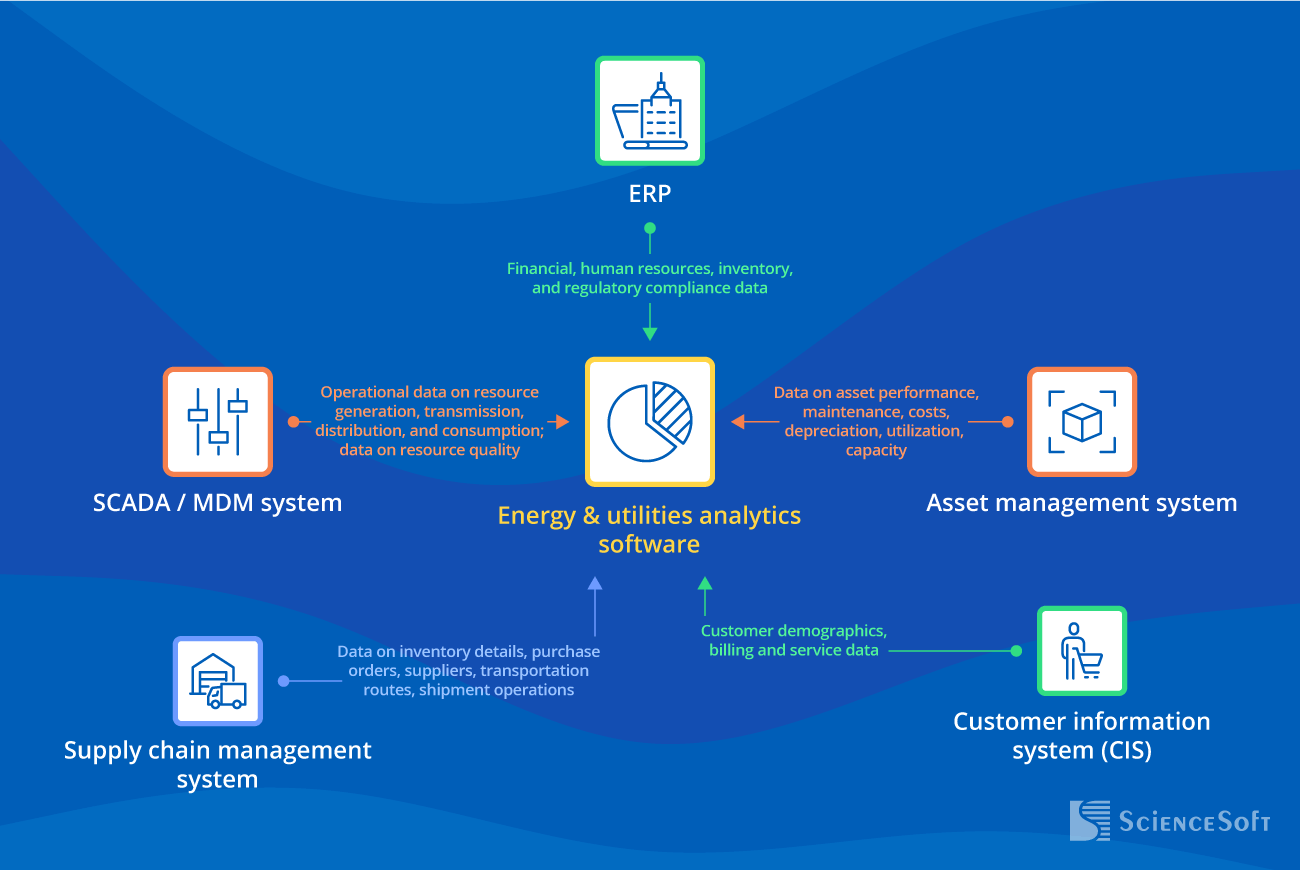Analytics in Energy & Utilities
A Complete Overview
In data analytics and AI since 1989, ScienceSoft builds custom analytics solutions to help energy & utilities companies gain full visibility into the performance of distribution networks and production sites, optimize asset utilization, reach ESG goals, and elevate customer experience.
Analytics for energy and utilities is needed to make informed decisions based on resource generation, distribution, and consumption data, equipment performance metrics, environmental impact, compliance regulations, and market situation.
Custom analytics solutions enable E&U organizations to integrate diverse data sources into a unified view and benefit from tailored analytics capabilities (including those based on proprietary ML models) for demand forecasting, DSM, predictive maintenance, and more.
- Implementation time: 2–6 months for an MVP.
- Implementation costs: $100,000–$1,000,000+, depending on the solution’s scope. Use our free online calculator to get a ballpark estimate for your case.
- Essential integrations: ERP, SCADA, MDM system, asset management system, SCM software, customer information system.
- ROI: up to 1600% (16:1) over three years when implementing comprehensive diagnostic and predictive maintenance solutions for large energy producers and T&D providers.
Key Analytics Software Capabilities for Energy & Utilities Companies
Energy and utilities analytics software development typically requires creating a significant share of custom code as each solution needs to be adapted to the specifics of the industry sector and each individual company. Below, our consultants list basic and advanced analytics features commonly requested by our clients in the E&U domain.
Essential Integrations for Energy & Utilities Analytics
Energy and utilities analytics software benefits from direct integrations with other enterprise systems, which can vary depending on the industry sector, the software and hardware systems in place, and more. Below, our specialists outline the core data sources for integration.

ERP
- To enable financial reporting and forecasting.
- To support accurate budget planning.
- To monitor compliance with environmental protection regulations.
- To optimize inventory management.
- To get insights into HR management processes.
SCADA or MDM system
- To identify resource consumption patterns and forecast resource demand.
- To spot and address utility network inefficiencies (e.g., water losses, energy waste) and enable alerting on critical events.
- To enable automated network load adjustment.
- To get insights for DSM programs.
- To identify cases of meter tampering fraud.
- To enable resource quality monitoring.
Asset management system
- To enable predictive and preventive asset maintenance.
- To enable data-driven assessment of asset ROI and financial performance.
Supply chain management system
- To enable inventory optimization.
- To optimize delivery routes.
Customer information system (CIS)
- To enable customer segmentation and personalize customer service.
- To understand customer sentiment towards the provided services.
- To ensure transparency across resource utilization and billing for customers.
What Can Enhance the Efficiency of Energy & Utilities Analytics
Visualization of network insights on maps
Having a map of the physical asset network and its real-time events helps plant managers, technicians, and engineers understand resource distribution patterns, promptly detect areas of outages, leaks, and other issues, and provide timely support to the affected sites.
Reports in regulatory-compliant formats
To save time and avoid errors, it is a good practice to implement report templates in the format required by regulators (e.g., FERC Form 1, EIA-860). Using the templates, the analytics solution can build such reports according to the established schedule or on demand and automatically send them to authorities.
Robust cybersecurity framework
To prevent data breaches and unauthorized access to SCADA and other internal systems, it is essential to implement robust access control management procedures, network security mechanisms (e.g., firewalls, intrusion detection systems), and encryption of data at rest and in transit.
Costs of Energy & Utilities Analytics Implementation
The costs of energy and utilities analytics implementation may vary from $100,000 to $1,000,000+. The investment size depends on each solution’s complexity, including its scale and integrations, the quality and nature of the data, the data processing speed (batch or real-time), and the need for ML/AI-powered capabilities.
Analytics for utilities and energy companies can bring a three-year ROI of up to 1600% with a 9-month payback period. The major ROI drivers are predictive maintenance and forecast-based demand planning capabilities, as well as higher customer satisfaction.
|
|
A basic solution |
A solution of medium complexity |
An advanced solution |
|---|---|---|---|
|
Data complexity
|
Structured data, e.g., CSV, XML, Parquet files. |
|
|
|
Data processing specifics
|
Batch processing (e.g., every hour, every 24 hours). |
Batch and real-time processing. |
Batch and real-time processing. |
|
Analytics complexity
|
Rule-based analytics. E.g., load demand forecasting based on historical demand data. |
Rule-based and ML/AI-powered analytics. E.g., load demand forecasting based on historical and real-time demand data. |
Rule-based and advanced ML/AI-powered analytics. E.g., AI-powered algorithms for smart thermostats to automatically adjust energy consumption based on real-time demand and pricing data. |
|
Reporting and visualization complexity
|
|
|
|
|
Costs
|
$100,000–$400,000 |
$400,000–$800,000 |
$800,000–$1,000,000+ |
82% of Energy & Utilities Companies Seek Advanced Analytics for Better Business Outcomes
Energy providers clearly understand that powerful analytics can drive better and faster decision-making, which can control costs, increase customer satisfaction, and provide a competitive advantage.
2023 ESG and Utility Dive Survey on Key Trends of Energy Providers
